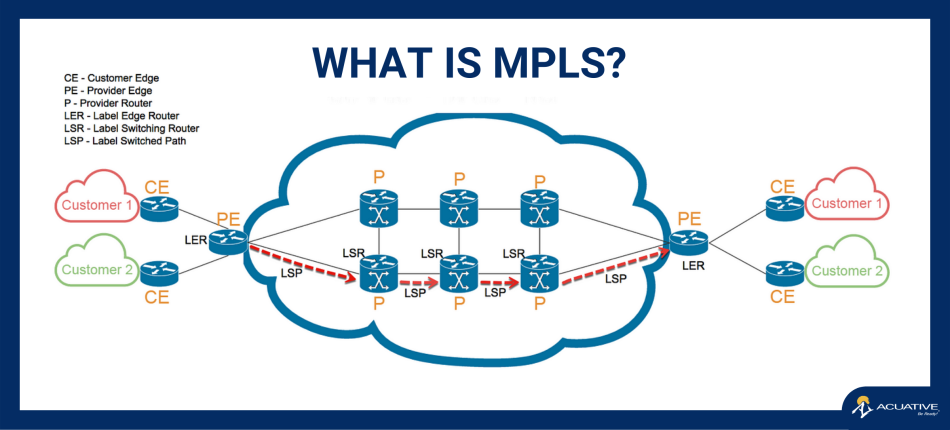Jonathan Balin
In the ever-evolving landscape of networking technologies, Multiprotocol Label Switching (MPLS) has emerged as a crucial component, providing efficient and reliable communication for businesses worldwide. But what exactly is MPLS? How does it compare to SD-WAN? And which solution is right for your business? In this comprehensive guide, we’ll break down the key differences between MPLS vs SD-WAN, their benefits, drawbacks, and why businesses are increasingly shifting toward SD-WAN for modern networking needs.
Contents:
- Defining MPLS
- Benefits of MPLS
- MPLS vs. SD-WAN
- Drawbacks of MPLS
- Elevating Your Network with Managed SD-WAN Services
Defining MPLS
Multiprotocol Label Switching (MPLS) is a protocol-agnostic technique designed to optimize the speed and efficiency of data transmission in a network. Unlike traditional routing, which examines the destination IP address to make forwarding decisions, MPLS employs labels to identify and route data packets through the network.
The MPLS network consists of routers that assign labels to data packets, creating predetermined paths known as Label Switched Paths (LSPs). These paths facilitate faster packet forwarding as routers no longer need to perform complex IP address lookups for every packet.
Benefits of MPLS
1. Traffic Engineering: MPLS enables the creation of specific paths for certain types of traffic, allowing for optimized resource utilization and improved network performance.
2. Quality of Service (QoS): By assigning different labels to packets, MPLS supports QoS, ensuring that high-priority traffic receives preferential treatment, leading to enhanced performance for critical applications.
3. Scalability: MPLS networks can scale efficiently to accommodate the growing demands of an organization without compromising performance.
4. Security: MPLS inherently offers a level of security by isolating traffic based on labels, making it more challenging for unauthorized users to intercept or manipulate data.
MPLS vs. SD-WAN
As businesses increasingly rely on cloud-based applications and services, the demand for flexible and agile networking solutions has risen. This is where Software-Defined Wide Area Networking (SD-WAN) comes into play. SD-WAN enhances network management by allowing centralized control, efficient traffic routing, and dynamic adaptation to changing network conditions.
What’s the difference between MPLS and SD-WAN? MPLS is a traditional, circuit-switched approach for routing network traffic, while SD-WAN leverages software-defined networking principles to dynamically and intelligently route traffic over multiple transport technologies, including technologies like MPLS, to optimize performance and cost. Some SD-WAN solutions utilize MPLS, but not all.
Some businesses are transitioning from MPLS to SD-WAN for the following reasons:
- Cost Savings – SD-WAN allows organizations to use cost-effective broadband and LTE while maintaining performance similar to MPLS.
- Cloud Readiness – MPLS was designed before cloud adoption, whereas SD-WAN seamlessly integrates with cloud applications.
- Scalability & Agility – SD-WAN enables businesses to add new locations or bandwidth quickly without waiting for provider upgrades.
Drawbacks of MPLS
Although MPLS is popular among enterprises for providing private connections between locations, MPLS has several drawbacks:
1. Cost: MPLS can be expensive to implement and maintain compared to alternative WAN technologies such as broadband internet. The dedicated nature of MPLS circuits often involves higher operational and capital expenses.
2. Complexity: MPLS networks can be complex to set up and manage, requiring specialized knowledge and skills. This complexity can lead to longer deployment times and increased dependence on skilled personnel.
3. Limited Bandwidth Scalability: MPLS services are typically provisioned with a specific amount of bandwidth, and scaling up can be time-consuming and may involve additional costs. This lack of flexibility in quickly adjusting bandwidth can be a drawback in dynamic network environments.
4. Single Point of Failure: MPLS networks are susceptible to single points of failure, as a disruption in the MPLS backbone or a provider's infrastructure can impact multiple sites connected to the network.
5. Dependency on Service Providers: Organizations relying on MPLS services are dependent on service providers for network connectivity. This dependency can limit the organization's ability to quickly adapt to changing business needs or to switch providers easily.
6. Limited Support for Cloud Services: MPLS was designed in an era where traditional data centers dominated, and it may not be optimized for the direct and efficient access to cloud services. This limitation can impact the performance of cloud-based applications for organizations relying heavily on cloud computing.
Elevating Your Network with Managed SD-WAN Services
Businesses can unlock the full potential of SD-WAN synergy by partnering with MSPs like Acuative. Acuative’s Managed SD-WAN services go beyond connectivity, offering a strategic optimization of your network. We offer enhanced agility, impeccable security, and improved application performance, all backed by our team of seasoned experts. Now that you understand MPLS and its role in relation to SD-WAN, consider how our comprehensive solutions can elevate your networking experience. You can trust us to not just connect your business, but to empower it for unparalleled success. Learn more about Acuative's SD-WAN services or contact us here for more info.

